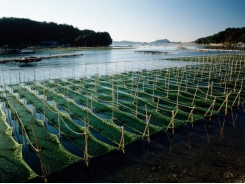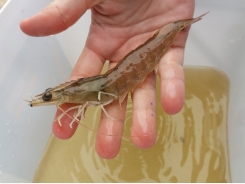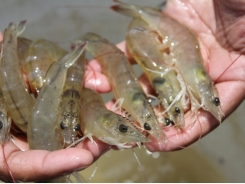Aquaculture Pond Aeration

You can see that in 2010-2011 there were many more problems with bacterial diseases than before. In the past, bacterial infection was seldom a problem with Pacific White Shrimp culture. This indicates that there is something wrong or something lacking with the aquaculture management practices used at present. Usually it is a problem with overfeeding. Excess feed causes a build up of waste materials in the pond, which encourages the growth of disease-causing Vibrio bacteria. When the oxygen or DO level in the pond drops over the course of the culture period, the shrimp are likely to get sick.
The most appropriate DO for shrimp health and normal growth is from no less than 4 mg/l (ppm) up to the saturation point. The amount of oxygen that can remain dissolved in the water depends on the water temperature. When the temperature is higher, the water can hold less oxygen. For shrimp culture it is best to maintain the DO at 6-8 mg/l, or no less than 4 mg/l all the time. In reality, on most farms the DO only stays this high during the first month or two of the culture period. On some farms, once the shrimp are 30 days old the night time DO, from about midnight to early morning before dawn, goes down to less than 3 ppm. This situation is found on extensive culture farms with no aerators and on semi-intensive culture farms or sometimes on intensive farms or sometimes on intensive farms.
New aquaculture business owners soon learn that aquatic farming has its benefits and rewards, but also its share of challenges and frustrations. The easy challenges turn out to be locating land for the farm and deciding on the source of food for the chosen specie. The tough challenges are pond sanitation, disease control, growth rates, affects of salinity and temperature, overcrowding, breeding habits, stress, and a dozen other obstacles that arise.
It turns out that oxygen is the focal point in nearly every one of these hard challenges. Specifically, proper amounts of dissolved oxygen at all times can greatly reduce or eliminate many of the obstacles that aquaculture farmers face.
The dissolved oxygen content of an aquaculture pond is a central key to water quality. In turn, water quality is vital to the financial health and productivity of the farming operation. The VaraCorp Turbine aerator is ideally suited to improve the water in aquaculture ponds. It employs the latest technology in self-aspirating aerators which infuse huge amounts of dissolved oxygen into the pond. This technology is based upon the physics principles of centrifugal force and precession as applied to the rotation of fluids.
O2-Turbine Aerator units are quiet, efficient, and cost effective. Not only is the oxygen transfer efficiency among the highest of all aeration devices, but the capital costs are among the lowest. The net result is that the Turbine aerator will pay for itself in less time than virtually any other aeration system through energy savings, reduced specie losses, and increased production.
The ability of any aeration device to place dissolved oxygen into an aquaculture pond is affected by the solubility of oxygen. This solubility is influenced by atmospheric pressure, hydro-statical pressure, and water temperature among other factors. Of these, water temperature is of most concern to the aquaculture farmer.
Dissolved oxygen enters the pond naturally at the air/water interface. This process is enhanced by wind action which creates a mild turbulence at the water surface. The other significant, natural means for oxygen production is through photosynthesis. As sunlight hits the water, phytoplankton and water plants use light energy to generate oxygen as a by-product of metabolism. In shallower aquaculture ponds the macro-vegetation and algae play a dominant role in oxygen production. In deeper ponds the phytoplankton account for most of the oxygen production.
Since photosynthesis is dependent upon sunlight, the dissolved oxygen content of an aquaculture pond can vary greatly over a 24-hour period. Starting gradually in the morning sunlight, the dissolved oxygen content increases until mid-afternoon when the sun is at its brightest. At this point photosynthesis begins to slow and stops completely after dark. If the intensity of sunlight is high during the day, meaning no cloud cover, enough oxygen can usually be produced to cover the oxygen demand during the night. On cloudy days the oxygen reserve can decrease to a level that is lethal to aquaculture species.
Even with intense sunlight, oxygen production can suffer if the water is not transparent enough to let the light penetrate. Ponds that are over-manured or foddered can result in over-production of plankton. These plankton then inadvertently screen the light from the deeper depths. Oxygen production is thus limited only to the surface region of the pond. Such production cannot meet the oxygen demands of the deeper layers of the pond. Some studies have shown that oxygen saturation levels at mid-afternoon must reach over 10 milligrams per liter (mg/l) to avoid an oxygen deficiency just before sunrise.
Aquaculture ponds are complex biological systems, and no two are exactly alike. Not only do they differ in oxygen production, but also oxygen consumption. While production depends largely upon light conditions and the air/water surface interface, consumption (i.e. respiration) depends upon water temperature and dissolved oxygen content in the pond. Studies have shown that the intensity of respiration among aquatic species tends to follow a specific daily rhythm. Respiration reaches its maximum daily level in the afternoon, and the rate of respiration is directly proportional to the available oxygen. On cloudy afternoons oxygen production can be at a low level while consumption is at its peak, leading to a deficiency.
An oxygen deficiency in an aquaculture pond does not have to result in a specie kill to be of concern. Studies have shown that the economics of the operation can be harmed by low oxygen levels. Saturated levels of dissolved oxygen at 25% or less can impact food intake, food utilization, conversion rates, and yields.
Artificial aeration means using a mechanical device to bring oxygen levels to the point which ensures the health of the species while maximizing the production goals of the farm. Today’s high intensity farms depend upon accelerated biological activity which tends to outstrip the natural oxygen supply. Artificial aeration then becomes a basic factor in production. Not only does it play a life-saving role in the health of the species, but also a life-saving role in the economics of the farm.
Most owners of large aquaculture farms know the importance of oxygen and employ some artificial means to increase it. Probably the most common type of pond aeration system used by these farmers is some version of the paddle wheel. While any aeration system is better than none, these paddle wheels might not be the best choice for an aquaculture pond. Besides producing large air bubbles that escape the water too quickly, these systems can be relatively high in initial costs and power consumption.
O2-Turbine Aerator shows the efficiency diffuser at saturating the surrounding water with dissolved oxygen. It does not take a trained eye to notice that the molecule size of this entrained oxygen is much smaller than that produced by a typical paddle wheel. Smaller molecules equate to a longer retention time in the pond. Ultimately, retention time of dissolved oxygen is a key factor in the ability of the farm specie to live and prosper.
The focus of pond aeration is not a matter of just trying to increase the oxygen levels but of regulating and monitoring the dissolved oxygen content. For example, if the oxygen content falls below 20%, food intake can drop below optimal levels. If the oxygen level is too high, say over 100%, it can force increased respiration and other problems. Thus, oxygen regulation plays a direct role in the economy of production. Every aquaculture business owner should use an oxygen meter to constantly monitor oxygen levels.
One reason oxygen monitoring is critical is that wind action can play a big role in oxygen content. During times of high winds it might be possible to reduce mechanical aeration to save on utility costs. Strong winds blowing over large ponds can diffuse up to 4.8 g/m2/day of oxygen into the water. The effect is less noticeable on small ponds where diffusion accounts for only 1.5 g/m2/day of oxygen.
Farms that are successful in keeping the DO at no less than 4 ppm even in the morning are usually very successful, with good growth rates, a high survival rate and a low FCR. When the DO is maintained at at least 4 ppm, there is seldom a problem with white feces disease or bacterial infections. In contrast, on farms where the DO drops below 4 ppm at night, the shrimp will grow slowly during the culture period and white feces disease is very common.
Related news
Tools

Phối trộn thức ăn chăn nuôi

Pha dung dịch thủy canh

Định mức cho tôm ăn

Phối trộn phân bón NPK

Xác định tỷ lệ tôm sống

Chuyển đổi đơn vị phân bón

Xác định công suất sục khí

Chuyển đổi đơn vị tôm

Tính diện tích nhà kính

Tính thể tích ao




 What makes feed more appealing for farm-raised shrimp?
What makes feed more appealing for farm-raised shrimp?  Experiences in shrimp genetic improvement in seven countries
Experiences in shrimp genetic improvement in seven countries